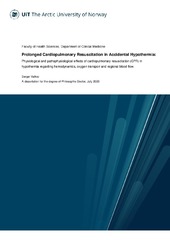| dc.contributor.advisor | Tveita, Torkjel | |
| dc.contributor.author | Valkov, Sergei | |
| dc.date.accessioned | 2023-12-08T13:00:04Z | |
| dc.date.available | 2023-12-08T13:00:04Z | |
| dc.date.issued | 2023-12-21 | |
| dc.description.abstract | This thesis was aimed to examine the physiological and pathophysiological effects of 3 hours continuous cardiopulmonary resuscitation (CPR) at 27°C concerning hemodynamics, oxygen transport, and regional blood flow. We aimed to explore mechanisms responsible for the successful resuscitation of accidental hypothermia victims in hypothermic cardiac arrest (HCA) and evaluate their value during prolonged mechanical CPR. We performed three randomized controlled animal studies using an intact porcine model. <p>
<p>Paper 1 describes changes in hemodynamics, O2 transport, and organ blood flow during 3-h stable hypothermia (27°C) and rewarming with spontaneous circulation using thoracic lavage as a rewarming method. The results of the study indicated that despite a hypothermia-induced substantial reduction in cardiac output (CO) and mean arterial pressure (MAP), compensatory responses could provide adequate O2 delivery and blood flow distribution to essential organs after rewarming from 3 hours hypothermia (27°C) <p>
<p>Paper 2 describes the effects of CPR using an automated chest compression device in replacing spontaneous CO during 3 hours at 27°C vs. 45 min at normothermia by determining hemodynamics, oxygen transport, and organ blood flow. We found that the level to which CPR could replace CO and MAP does not change in hypothermia. Moreover, 3 hours CPR at 27°C could provide marginal but sufficient global oxygen delivery to sustain aerobic metabolism. In contrast, normothermic CPR for 45 min showed impaired hemodynamics, oxygen transport and organ blood flow. <p>
<p>Paper 3 was aimed to investigate autoregulation of cerebral blood flow and cerebral oxygen transport during 3-h hypothermic CPR at 27°C compared to spontaneous circulation at the same temperature. Potent physiological compensatory responses during 3-h CPR provided unaltered cerebral oxygen delivery as at spontaneous circulation and maintained aerobic metabolism and autoregulation of cerebral blood flow during 2h of hypothermic CPR. <p>
<p>Results from Paper I -III support using early and continuous CPR in accidental hypothermia patients in HCA under rescue and transport to hospitals capable of introducing specific rewarming techniques. | en_US |
| dc.description.doctoraltype | ph.d. | en_US |
| dc.description.popularabstract | Medical professionals worldwide report cases describing successful resuscitation and rewarming of accidental hypothermia victims with cardiac arrest without or with minimal neurological sequelae. It was possible even when body temperature was as low as 13,7 °C and cardiac arrest lasted almost 7 hours. To find out and evaluate some possible mechanisms for that, we have cooled pigs down to 27°C. We first assessed the effects of 3-hours hypothermia and subsequent rewarming with a beating heart. We discovered that the blood flow and oxygen delivery was restored after rewarming in essential organs - brain and heart- despite cardiac dysfunction due to hypothermia. After that, we studied the effects of CPR for 3 hours at the same temperature without rewarming, employing an automated CPR device. We found that blood flow generated by CPR could sustain sufficient oxygen delivery to maintain aerobic metabolism, and cerebral autoregulation was functioning, providing unaltered brain blood flow during the first 2 of 3 hours of CPR. | en_US |
| dc.description.sponsorship | The Research Council of Norway and Barents 2020 | en_US |
| dc.identifier.uri | https://hdl.handle.net/10037/31973 | |
| dc.language.iso | eng | en_US |
| dc.publisher | UiT The Arctic University of Norway | en_US |
| dc.publisher | UiT Norges arktiske universitet | en_US |
| dc.relation.haspart | Paper I: Valkov, S., Mohyuddin, R., Nilsen, J.H., Schanche, T., Kondratiev, T.V., Sieck, G.C. & Tveita, T. (2019). Organ blood flow and O2 transport during hypothermia (27°C) and rewarming in a pig model. <I>Experimental Physiology, 104</i>(1), 50–60. Also available at <a href=https://doi.org/10.1113/EP087205> https://doi.org/10.1113/EP087205</a>. <p>
<p>Paper II: Nilsen, J.H., Valkov, S., Mohyuddin, R., Schanche, T., Kondratiev, T.V., Naesheim, T., Sieck, G.C. & Tveita, T. (2020). Study of the Effects of 3 h of Continuous Cardiopulmonary Resuscitation at 27°C on Global Oxygen Transport and Organ Blood Flow. <I>Frontiers in Physiology</i>, 11:213. Also available in Munin at <a href=https://hdl.handle.net/10037/18567>https://hdl.handle.net/10037/18567</a>. <p>
<p>Paper III: Valkov, S., Nilsen, J.H., Mohyuddin, R., Schanche, T., Kondratiev, T., Sieck, G.C. & Tveita, T. (2022). Autoregulation of Cerebral Blood Flow During 3-h Continuous Cardiopulmonary Resuscitation at 27°C. <i>Frontiers in Physiology</i>, 13:925292. Also available in Munin at <a href=https://hdl.handle.net/10037/27468>https://hdl.handle.net/10037/27468</a>. | |
| dc.rights.accessRights | openAccess | en_US |
| dc.rights.holder | Copyright 2023 The Author(s) | |
| dc.rights.uri | https://creativecommons.org/licenses/by-nc-sa/4.0 | en_US |
| dc.rights | Attribution-NonCommercial-ShareAlike 4.0 International (CC BY-NC-SA 4.0) | en_US |
| dc.subject | VDP::Medisinske Fag: 700::Klinisk medisinske fag: 750::Anestesiologi: 765 | en_US |
| dc.subject | VDP::Medical disciplines: 700::Clinical medical disciplines: 750::Anesthesiology: 765 | en_US |
| dc.title | Prolonged Cardiopulmonary Resuscitation in Accidental Hypothermia:
Physiological and pathophysiological effects of cardiopulmonary resuscitation (CPR) in hypothermia regarding hemodynamics, oxygen transport and regional blood flow | en_US |
| dc.type | Doctoral thesis | en_US |
| dc.type | Doktorgradsavhandling | en_US |


 English
English norsk
norsk
